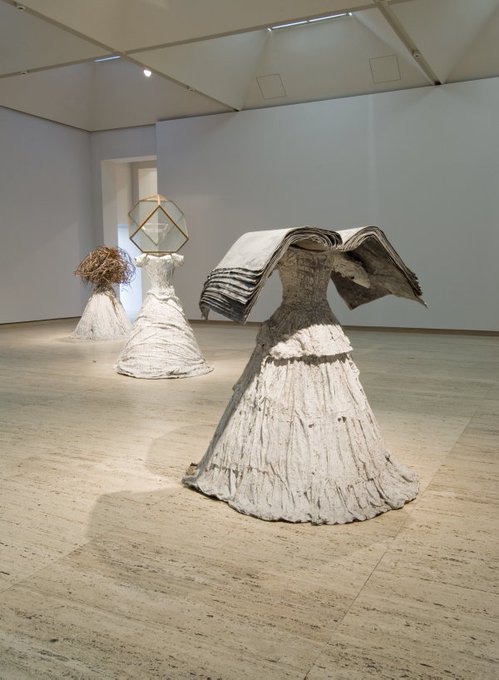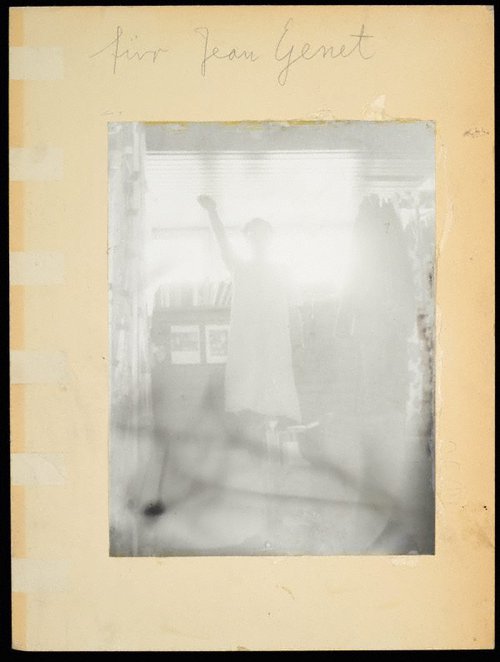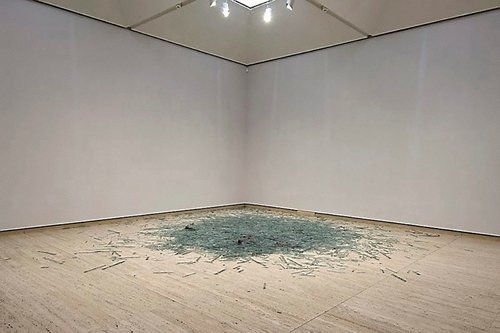-
Details
- Other Titles
- Order of the Seraphim
Faith, hope, charity/love - Alternative title
- Die Ordnung der Engel
- Date
- 1984-1986
- Media category
- Mixed media painting
- Materials used
- emulsion, synthetic polymer paint, shellac on photodocument paper on canvas (linen) with lead
- Dimensions
-
280.0 x 380.0 x 75.0 cm overall
:
a - canvas, 280 x 380 x 20 cm, stretcher
b - propeller, 127 x 25.5 cm, blade - glaube
b - propeller, 120 x 26 cm, blade - liebe
b - propeller, 130 x 24.5 cm, blade - hoffnung
b - propeller, 23 x 30 x 60 cm, nose (irreg)
- Signature & date
Not signed. Not dated.
- Credit
- Mervyn Horton Bequest Fund 1987
- Location
- Not on display
- Accession number
- 358.1987.a-b
- Copyright
- © Anselm Kiefer
- Artist information
-
Anselm Kiefer
Works in the collection
- Share
-
-
About
There are two powerful strands to Kiefer’s work since the early 1980s; a philosophical investigation into the problems of representing transcendence and experimentation with materials and images to create hybrid forms between paintings and sculpture that confound traditional representations of space.
Kiefer describes both these enquiries as journeys into the unknown. The idea of the journey is a metaphor that he often includes in images and in material processes. In ‘Glaube, Hoffnung, Liebe’ the journey is potentially a flight that would take us from the material plane into the heavens and yet the propeller is made of lead and will never fly. The words in the title are inscribed on the three blades, they are St Paul’s three cardinal virtues; faith, hope and love. Perhaps Kiefer is implying that neither technology nor the exercise of virtue can achieve literal transcendence and yet he is constantly asking the question, why not?
Applying an object such as this lead propeller to a representation of a landscape contradicts the logic of spatial representation. Where in the space of the painting do we locate the object? Is it lying on the rock shelf or hurtling through space? In fact it is not in the space of the painting at all but hovers as if in a separate dimension or representational register. Yet the two kinds of space are magically integrated so that we don’t see one or the other but both at once something akin to the strange behaviour of quantum physics.
-
Exhibition history
Shown in 5 exhibitions
Anselm Kiefer: bilder 1986-1980, Stedelijk Van Abbemuseum, Eindhoven, 20 Dec 1986–08 Feb 1987
Acquisitions from the Komon, Salkauskas and Horton Funds, Art Gallery of New South Wales, Sydney, 05 May 1987–31 May 1987
1988 Australian Biennale: from the Southern Cross: a view of world art c.1940-88, Art Gallery of New South Wales, Sydney, 18 May 1988–03 Jul 1988
Great gifts, great patrons, Art Gallery of New South Wales, Sydney, 17 Aug 1994–19 Oct 1994
Signs and symbols to live by, Art Gallery of New South Wales, Sydney, 16 Jun 2016–19 Mar 2017
-
Bibliography
Referenced in 16 publications
-
Art Gallery of New South Wales, Great gifts, great patrons: an exhibition celebrating private patronage of the Gallery, Sydney, 1994. no catalogue numbers
-
Wim Beeren, Anselm Kiefer: bilder 1986-1980, Eindhoven, 1986, 68, 69 (colour illus.). cat.no. 24
-
Anthony Bond, Anselm Kiefer: aperiatur terra, 'Fields of reference', pg.50-57, London, 2007, 52 (colour illus.), 53.
-
Anthony Bond and Victoria Lynn, AGNSW Collections, 'Contemporary Practice - Here, There, Everywhere ...', pg. 229-285, Sydney, 1994, 257 (colour illus.).
-
Anthony Bond, Art Gallery of New South Wales handbook, 'Contemporary', pg. 94-108, Sydney, 1988, 97, 98-99 (colour illus.).
-
Donna Brett, Contemporary: Art Gallery of New South Wales Contemporary Collection, 'Expression and the figure', pg.108-153, Sydney, 2006, 112, 136, 137 (colour illus.), 430, 436.
-
Carmen de Cima Suárez and Ana Vázquez de la Cueva, Aeronáutica y Pintura, Spain, 2001, 222, 223 (colour illus.).
-
Bruce James, Art Gallery of New South Wales handbook, 'Western Collection: Paintings and Sculpture', pg. 17-77, Sydney, 1999, 75 (colour illus.).
-
John O'Neill (Editor in Chief) and Barbara Cavaliere (Editor), Anselm Kiefer - works on paper in the Metropolitan Museum of Art, New York, 1998, 62 (illus.). fig.no. 17
-
Margaret Plant, Art and Australia (Vol. 26, No. 2), 'Sydney Biennales', pg. 254-263, Sydney, Summer 1988, 262.
-
Jill Sykes, Look, 'New on two', pg. 18-19, Sydney, Sep 2006, 18.
-
Michael Wardell, Look, 'Mervyn Horton's bequest', pg. 11-12, Sydney, Jun 2004, 12.
-
Nick Waterlow (Director), The 1988 Australian Biennale: from the Southern Cross: a view of world art c.1940-88, Sydney, 1988, 162, 163 (colour illus.). no catalogue numbers
-
Donald Williams and Barbara Vance Wilson, From caves to canvas: an introduction to western art, 'Painting Now: Transavantguardia and a new expressionism', pg.272-292, Sydney, 1992, 281 (illus.).
-
Donald Williams and Colin Simpson, Art now: contemporary art post - 1970, Sydney, 1994, 181 (illus.). fig.no. 10.4
-
Donald Williams and Barbara Vance Wilson, From caves to canvas: an introduction to western art (Second edition), 'Art of the '80s: Graffiti, New Expressionism, Post -'70s Architecture', pg.337-363, Sydney, 1998, 341 (colour illus.).
-




